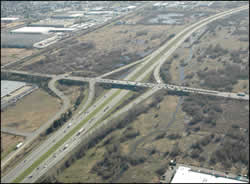FHWA Localized Bottleneck Reduction Program
Case Study
Printable Version [PDF 118KB]
You may need the Adobe® Reader® to view the PDF on this page.
Contact Information: Neil Spiller at Neil.Spiller@dot.gov
 SR 167 at 15th Street NW, Renton, Washington
SR 167 at 15th Street NW, Renton, Washington
Location – Renton, Washington
SR 167 at 15th Street NW in Renton, Washington.
Problem – Bottleneck caused by a lane drop
On southbound SR 167, drivers experienced significant congestion on a regular daily basis. The slowdowns were at their worst during the mid-afternoon commute when the Boeing facility in Renton had their afternoon shift change, contributing to major traffic volumes in the corridor. The problem was compounded by a lane drop in the southbound direction from the 15th Street NW interchange to a point just north of SR 18.
Solution – Convert shoulder to full-use lane
A citizen submitted a comment via the WSDOT web site, suggesting that the chokepoint could be reconfigured through the 15th Street NW interchange to extend the three-lane continuity within the corridor up to the SR 18 interchange, thereby improving traffic flow during the heavy afternoon commute. The total lane reconfiguration spanned roughly 3,500 feet centered on the 15th Street northwest interchange. By utilizing the available full-depth shoulders, WSDOT found that an additional lane could be added by reconfiguring the lanes to include 2.5-foot shoulders and three 11-foot lanes. The previous operational configuration consisted of a drop lane at the off-ramp and an add lane at the on-ramp. The drop lane was converted to an option exit, the add lane to a merge, and signing was modified appropriately. The existing ITS counter loops were shifted laterally and a new third lane loop was installed. It was found that significant rutting in the pavement existed, which could pose problems to vehicles with the new lateral shift. Therefore, it was decided that the crowns of the rutting would be ground down, and sand seal would be installed to protect the new roadway surface. The project was completed in September 2002, with a total project cost of $42,000.
Lesson Learned
Following implementation, WSDOT conducted an "after" study and found that during the evening peak, total vehicle throughput increased by 10 percent for the two miles between 277th and 15th Street NW; average speeds increased by 10 to 20 mph; and vehicle queuing was significantly reduced. This project demonstrates how low-cost bottleneck improvements can make significant improvements in traffic flow.